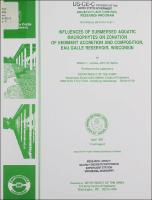Please use this identifier to cite or link to this item:
https://hdl.handle.net/11681/6372| Title: | Influences of submersed aquatic macrophytes on zonation of sediment accretion and composition, Eau Galle Reservoir, Wisconsin |
| Authors: | James, William F., Aquatic biologist Barko, John W. |
| Keywords: | Accretion Littoral zone Macrophytes Aquatic plants Water chemistry Reservoirs Eau Galle (Wis.) Profundal zone Sediment composition Sediment erosion Sediment focusing Sediment transport Zones of sediment accretion Aquatic Plant Control Research Program (U.S.) |
| Publisher: | U.S. Army Engineer Waterways Experiment Station |
| Series/Report no.: | Technical Report (Aquatic Plant Control Research Program (U.S.)) ; no.Technical Report A-91-1 |
| Abstract: | Sediment accretion and composition were examined in vegetated and nonvegetated regions across all depths in Eau Galle Reservoir, Wisconsin. Within riverine areas, delta formation was observed. In the lacustrine area of the reservoir (i.e., nonriverine), both sediment accretion and moisture content decreased while sediment density increased, along a gradient of decreasing depth between 9 and 2.5 m. However, accretion again increased at shallower depths (<2.5 m) occupied by submersed macrophytes. Based on differences in sediment accretion and composition, four zones of sediment accretion were distinguished in the lacustrine area : an accumulation zone (>6 m), a transport zone (3.5 to 6 m), an erosional zone (2.5 to 3.5 m), and a vegetated littoral zone (<2.5 m). Low-density sediments with relatively high organic matter and nutrient concentrati ons were found in both the littoral and accumulation zones, while high-density sediments with low organic matter and nutrient concentrations were found in the erosional zone. Dispersion of sediment from pans placed in the littoral zone was greatest during vernal mixing, when macrophyte biomass was low. Sediment dispersion decreased substantially as macrophytes grew, and remained low during autumnal overturn, when macrophyte standing crop was near peak biomass. Sediment dispersion was high throughout the study in the nonvegetated erosional zone. Marked differences in sediment composition between the littoral and erosional zones, and the occurrence of high rates of sediment accretion in the littoral zone, suggest that submersed macrophytes have been influential both in reducing sediment erosion and promoting sediment accretion in the shallow regions of Eau Galle Reservoir. |
| Description: | Technical Report |
| Gov't Doc #: | Technical Report A-91-1 |
| Rights: | Approved for public release; distribution is unlimited |
| URI: | http://hdl.handle.net/11681/6372 |
| Appears in Collections: | Technical Report |
Files in This Item:
| File | Description | Size | Format | |
|---|---|---|---|---|
| TR-A-91-1.pdf | Technical Report A-91-1 | 4.11 MB | Adobe PDF |  View/Open |